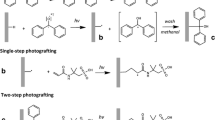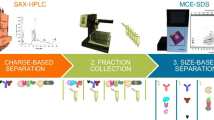Abstract
In recent years, protein therapeutics have seen increasing use in the therapeutic arena. As with traditional small molecule drug substances, one is obligated to ensure purity and stability of the various dosage forms. With these higher molecular weight therapeutics, a common approach for analytical characterization is enzymatic digestion followed by gradient elution liquid chromatography with mass spectrometry detection to create a peptide map (bottom-up protein analysis). Due to the difficulty to separate mixtures frequently encountered, there is the need for advanced chromatographic systems featuring increased resolution and/or peak capacity that can be operated in the gradient elution format. Presently, we describe an extreme ultra-pressure liquid chromatography (XUPLC) system that has been implemented as an in-house add-on to a commercial ultra-pressure chromatography system. This add-on allows operation at the 38 Kpsi range, accommodates the use of capillary columns in excess of 1 m packed with sub-2-µm particles and can be operated in the gradient elution format. To evaluate the utility of this system, rat growth hormone was used as a model protein and was exposed to light (λ 254 nm) to create a stress environment. When enzymatic digests of control and stressed protein were analyzed with the XUPLC system using MS detection, greater than 92% peptide coverage was achieved, including the identification some peptides where pre-oxidation of Met residues had occurred, as well as chemistry specifically related to the photolysis of protein disulfide linkages. When the same samples were analyzed by commercial UPLC and compared to the XUPLC results, the utility of the increased peak capacity available with the XUPLC was apparent as previously co-eluting peaks were now well resolved. In particular, one specific degradation route was identified where a pair of isobaric cis/trans diastereomerically related peptides were well resolved by XUPLC while they were unresolved by UPLC. Clearly the use of this system operating at a higher pressure regime with long capillary columns is and will be useful in continued investigations of protein stability, especially in cases where only subtle differences in the amino acid residues have occurred during degradation.











Similar content being viewed by others
References
The Nobel Prize in Physiology or Medicine 1923 (2016) Nobelprize.org. Nobel Media AB 2014. Web. 6 May 2016. http://www.nobelprize.org/nobel_prizes/medicine/laureates/1923
Hawe A, Wiggenhorn M, Van de Weert M, Garbe JHO, Manler H-C, Jiskoort W (2012) Forced degradation of therapeutic proteins. J Pharm Sci 101(3):895–913
Dimitrov DS (2012) Therapeutic proteins. Methods Mol Biol 899:1–26
Siahaan TJ, Schöneich C (2013) In: Hovgaard L, Frokjaer S, van de Weert M (eds) Pharmaceutical formulation development of peptides and proteins, 2nd edn. CRC Press, Boca Raton
Kerwin BA, Remmele RL Jr (2007) Protect from light: photodegradation and protein biologics. J Pharm Sci 96(6):1468–1479
Creed D (1984) The photophysics and photochemistry of the near-UV absorbing amino acids I. Tryptophan and its simple derivatives. Photochem Photobiol 39(4):537–562
Vogt W (1995) Oxidation of methionyl residues in proteins: tools, targets, and reversal. Free Radic Biol Med 18(1):93–105
Barrón LB, Waterman KC, Filipiak P, Hug GL, Nauser T, Schöneich C (2004) Mechanism and kinetics of photoisomerization of a cyclic disulfide, trans-4,5-1,2-dithiacyclohexane. J Phys Chem A 108:2247–2255
Mozziconacci O, Sharov V, Williams TD, Kerwin BA, Schöneich C (2008) Peptide cysteine thiyl radicals abstract hydrogen atoms from surrounding amino acids: the photolysis of a cystine containing model peptide. J Phys Chem B 112:9250–9257
Mozziconacci O, Williams TD, Kerwin BA, Schöneich C (2008) Reversible intramolecular hydrogen transfer between protein cysteine thiyl radicals and αC–H bonds in insulin: control of selectivity by secondary structure. J Phys Chem B 112:15921–15932
Mozziconacci O, Kerwin BA, Schöneich C (2010) Photolysis of an intrachain peptide disulfide bond: primary and secondary processes, formation of H2S, and hydrogen transfer reactions. J Phys Chem B 114:3668–3688
Mozziconacci O, Kerwin BA, Schöneich C (2010) Reversible hydrogen transfer between cysteine thiyl radical and glycine and alanine in model peptides: covalent H/D exchange, radical–radical reactions and l- to d-ala conversion. J Phys Chem B 114:6751–6762
Mozziconacci O, Kerwin BA, Schöneich C (2010) Exposure of a monoclonal antibody, IgG1, to UV-light leads to protein dithiohemiacetal and thioether cross-links: a role for thiyl radicals? Chem Res Toxicol 23:1310–1312
Zhou S, Mozziconacci O, Kerwin BA, Schöneich C (2013) The photolysis of disulfide bonds in IgG1 and IgG2 leads to selective intramolecular hydrogen transfer reactions of cysteine thiyl radicals, probed by covalent H/D exchange and RPLC-MS/MS analysis. Pharm Res 30:1291–1299
Mozziconacci O, Schöneich C (2014) Sequence-specific formation of D-amino acids in a monoclonal antibody during light exposure. Mol Pharm 11:4291–4297
Yates JR, Ruse CI, Nakorchevsky A (2009) Proteomics by mass spectrometry: approaches, advances, and applications. Annu Re Biomed En 11:49–79
Dolan JW, Snyder LR, Djordjevic NM, Hill DW, Waeghe TJ (1999) Reversed-phase chromatographic separation of complex samples by optimizing temperature and gradient time I. Peak capacity limitations. J Chromatogr A 857:1–20
Knox JH (1977) Practical aspects of LC theory. J Chromatogr Sci 15:352–364
Snyder LR, Dolan JW (2007) High-performance gradient elution: the practical application of the linear-solvent-strength model. Wiley Interscience, Hoboken
Neuw UD (1997) HPLC columns: theory. Technology and practice. Wiley-VCH, New York
Snyder LR, Stadalius MA (1986) In: Horváth C (ed) High-performance liquid chromatography: advance and perspectives, vol 4. Academic Press, Orlando
MacNair JE, Lewis KC, Jorgenson JW (1997) Ultrahigh-pressure reversed-phase liquid chromatography in packed capillary columns. Anal Chem 69:983–989
Dong MW (2013) Myths in ultrahigh-pressure liquid chromatography. LCGC N Am 31:868–880
Jorgenson JW (2010) Capillary liquid chromatography at ultrahigh pressures. Annu Rev Anal Chem 3:129–150
Angus PDA, Demarest CW, Catalano T, Stobaugh JF (2000) Aspects of column fabrication for packed capillary electrochromatography. J Chromatogr A 1126:50–57
Franklin EG (2012) Utilization of long columns packed with sub-2 µm particles operated at high pressures and elevated temperatures for high-efficiency on-dimensional liquid chromatography separations. The University of North Carolina at Chapel Hill, Chapel Hill
Stobaugh JT (2012) Strategies off differential proteomic analysis by liquid chromatography–mass spectrometry. The University of North Carolina at Chapel Hill, Chapel Hill
Grinias KM, Godinho JM, Franklin EG, Stobaugh JT, Jorgenson JW (2016) Development of a 45 Kpsi ultrahigh pressure liquid chromatography instrument for gradient separations of peptides using long microcapillary columns and sub-2 µm particles. J Chromatogr A 1469:60–67
Woods JM (2014) Fluorogenic derivatization of pro-quinoidal species: from biogenic amines to protein bound 3-nitrotyrosine. In: Appendix, implementation of chromatographic systems which surpass commercial pressure limits for enhanced resolution and peak capacity. The University of Kansas Lawrence
Rosano GL, Ceccarelli EA (2014) Recombinant protein expression in Escherichia coli: advances and challenges. Front Microbiol 5:1–17
Knox JH (1976) Gradient storage method for liquid chromatography. US Patent 3.981,801
Davis M, Stahl D, Lee T (1995) Low flow high-performance liquid chromatography solvent delivery system designed for tandem capillary liquid chromatography–mass spectrometry. J Am Soc Mass Spectrom 6:571–577
Cortes HJ, Pfeiffer CD, Richter BE, Stevens TS (1987) Porous ceramic bed supports for fused silica packed capillary columns used in liquid chromatography. J High Res Chromatogr Chromatogr Commun 10:446–448
Lenza RFS, Vasconcelos WL (2001) Structural evolution of silica sols modified with formamide. Mater Res 4:175–179
Robards K, Haddad PR, Jackson PE (1994) Principles and practice of modern chromatographic methods. Academic Press, London
Stadalius MA, Gold HS, Snyder LR (1984) Optimization model for the gradient elution separation of peptide mixtures by reversed-phase high-performance liquid chromatography. J Chromatogr 296:31–39
Snyder LR, Kirkland JJ, Glajch JL (1997) Practical HPLC method development, 2nd edn. Wiley, New York
Acknowledgements
The University of Kansas-based investigators gratefully acknowledge the J.R. and Inez Jay funds, awarded to MLF by the Higuchi Biosciences Center at The University of Kansas, for providing partial funding for this research, and the numerous discussions and fabrication assistance from JTS and our collaborators at UNC Chapel Hill.
Author information
Authors and Affiliations
Corresponding author
Electronic supplementary material
Below is the link to the electronic supplementary material.
Rights and permissions
About this article
Cite this article
Mozziconacci, O., Stobaugh, J.T., Bommana, R. et al. Profiling the Photochemical-Induced Degradation of Rat Growth Hormone with Extreme Ultra-pressure Chromatography–Mass Spectrometry Utilizing Meter-Long Microcapillary Columns Packed with Sub-2-µm Particles. Chromatographia 80, 1299–1318 (2017). https://doi.org/10.1007/s10337-017-3344-9
Received:
Accepted:
Published:
Issue Date:
DOI: https://doi.org/10.1007/s10337-017-3344-9




